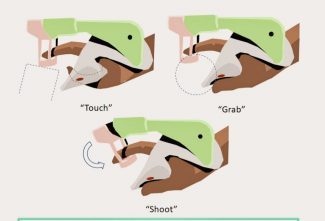As VR display resolutions become more packed with pixels and new controller types such as Valve’s Knuckles dangle tantalizingly in front of us, one thing that often goes overlooked is haptic feedback. There are plenty of companies out there working to help define the first real haptic standard outside of tiny vibration motors seen already in VR motion controllers, and now it appears Microsoft can be counted among them with their newly revealed CLAW controller prototype.
CLAW, Microsoft describes in a recent blog post, is a handheld VR controller designed to “augment the typical controller functionality with force feedback and actuated movement to the index finger.”
With it, Microsoft researchers say it mimics the feeling of grasping virtual objects, touching virtual surfaces, and depressing triggers. Microsoft researchers say it also changes its corresponding haptic configuration by sensing the differences in the user’s grasp.
The prototype contains a servo motor coupled with a force sensor, which imparts force on the index finger during grasping and touching. Using HTC’s Vive Tracker for positional tracking, the prototype also incorporates a vibrating actuator at the index fingertip to mimic virtual textures. While somewhat less exciting in its implications, CLAW can also reconfigure to a trigger mode that delivers haptic force feedback to simulate pulling a trigger on a gun.
Microsoft researchers carried out two user studies, detailed in the full research paper. The first study, researchers say, “obtained qualitative user feedback on the naturalness, effectiveness, and comfort when using the device,” while the second study details the ease of the transition between grasping and touching when in use.
Microsoft’s CLAW may not be the foundation of a new haptic controller standard, but to its credit, it does reduce the complexity of 5-finger setups considerably by focusing solely on the index finger. While it’s clear that force feedback and a buzzing actuator on a single finger isn’t what we’d call anywhere near ‘complete’, it’s certainly a step in a different direction.









